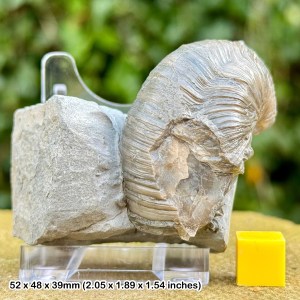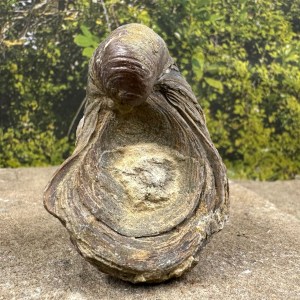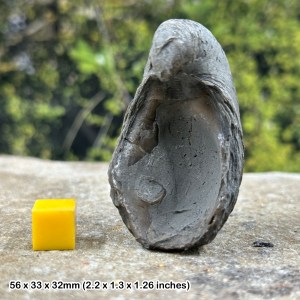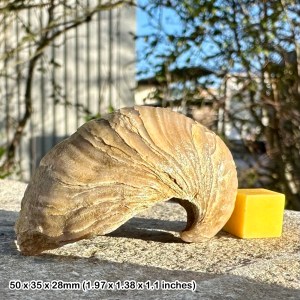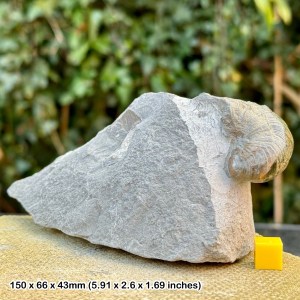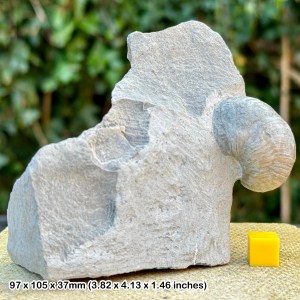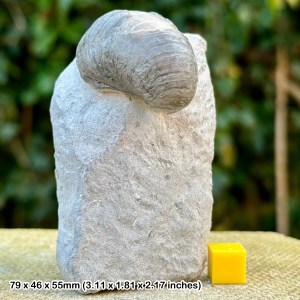For those who have visited Watchet in Somerset looking for fossils in the Blue Lias, this location will seem remarkably similar. Indeed, the same fossils can be found in thick limestone bands and soft shale. Hock Cliff is a classic Jurassic location to explore.
DIRECTIONS
♦ From the A38, head to Frampton-on-Severn. Drive through the village and, where the road crosses the canal and veers to a sudden right hand bend, take the road ahead to Fretherne.
♦ Go through the village, passing the church. You will see a footpath on your left. Pass this and continue up the road, where you will find parking for one car near a farm gate. Do not block this gate.
♦ Walk back down the road onto the footpath and follow it in a straight line until you reach Hock Cliff on the banks of the River Severn. There are now two footpaths – one going left along the Severn and one to the right. Continue along the footpath to the left, and where the cliffs end, you will find easy access to the foreshore. There are several stiles and gates to get through, with a final gate where the cliff ends.
♦ Ref: 51.77845°N, 2.39236°W
PROFILE INFO
FIND FREQUENCY: ♦♦♦ – Fossils can often be found and, usually, you can come away with some nice specimens. This may depend on whether the foreshore beds are washed out and if mud has not covered the rocks. Some fossils are poorly preserved in the shale.
CHILDREN: ♦♦♦♦ – A rocky foreshore with often slippery rocks, makes this location unsuitable for children. Older children must be supervised, and kept away from the cliffs and the mud flats.
ACCESS: ♦♦♦ – The location is easy to find, but there is a bit of a walk to the foreshore. The foreshore can also be hard going, especially at the middle section of the cliff, where the steep foreshore rocks can be slippery. There are no toilets near this site.
TYPE: – Fossils are mostly found in the foreshore rocks, but, where the cliffs have been washed out and extend as a foreshore platform, they can be easily collected from these beds.
FOSSIL HUNTING
When you first enter the beach at Hock Cliff, if you have collected from the Blue Lias of Somerset, you will immediately recognise the same formation here – bands of limestone, with thinly laminated shale in between. Indeed, the same fossils can be found. At the first part of the cliff, you can search the fallen blocks of limestone. These can contain ammonites, belemnites and shells, such as brachiopods and bivalves. You will need a good hammer, as some of the bands can be quite hard.
As you get to the middle part of the cliff, you will notice the hard bands on the foreshore, with shale in between. The River Severn regularly washes these beds out. In these areas of shale, crinoids, ammonites, reptile remains and brachiopods can be found. A layer full of Gryphaea can also be seen.
The only problem with Hock Cliff is that the lovely pyritic ammonites that can be found both here and at Watchet are too oxidised and so are usually poorly preserved or heavily decayed. However, there are plenty of other fossils and ammonites in the limestone to be collected.

GEOLOGY
Most locations along the River Severn feature most of the cliffs being Triassic with the uppermost beds being Jurassic. Here, the Triassic beds are below beach level, so the beds exposed are of the Jurassic Blue Lias Formation of the Lias Group.
Occasionally, the Westbury Formation containing the famous bone bed, as seen at Aust, can be exposed at low tide during favourable conditions but it is nearly always covered up with mud.
The cliffs here are a series of limestone bands with shale in between. The rocks are Hettangian in age.


SAFETY
The use of common sense and knowledge of tide times is essential for all locations. Here, the River Severn often reaches the base of the cliff. The mudflats can also be a danger and the mud itself makes the foreshore rocks extremely slippery. The Severn Bore affects this location, during which a surge of water runs past this part of the river. Do not visit this location when a bore is due. For bore times, go to: http://www.severn-bore.co.uk.
EQUIPMENT
You will need a good hammer and chisel and for fossils in the shale, paper to wrap your finds and something to put them in. A pick will also be handy for the shale and a knife for removing fossils.
ACCESS RIGHTS
This site is a site of special scientific interest (SSSI). This means you can visit the site, but hammering the bedrock is not permitted. For full information about the reasons for the status of the site and restrictions, download the PDF from Natural England.
It is important to follow our ‘Code of Conduct’ when collecting fossils or visiting any site. Please also read our ‘Terms and Conditions‘
LINKS
♦ Buy Fossils, Crystals, Tools
♦ Location Discussions
♦ Deposits Magazine
♦ Join Fossil Hunts
♦ UK Fossils Network
-
Authentic Gryphaea (Devil’s Toenail) Shell Fossil with Stand – Blue Lias, Jurassic, Hock Cliff – COA
£18.00 -
Fossil Gryphaea bivalve, “Devil’s toenail” an iconic fossil from the Jurassic of Gloucestershire
£4.80 -
Fossil Gryphaea bivalve, “Devil’s toenail” an iconic fossil from the Jurassic of Gloucestershire
£7.20 -
Fossil Gryphaea bivalve, “Devil’s toenail” an iconic fossil from the Jurassic of Gloucestershire
£7.20 -
Fossil Gryphaea bivalve, “Devil’s toenail” an iconic fossil from the Jurassic of Gloucestershire
£7.20 -
Genuine Fossil Gryphaea Shell (Devil’s Toenail) – Jurassic: Hock Cliff, Gloucestershire, UK – COA
£24.00 -
Genuine Fossil Gryphaea Shell (Devil’s Toenail) – Jurassic: Hock Cliff, Gloucestershire, UK – COA
£24.00 -
Genuine Fossil Gryphaea Shell (Devil’s Toenail) – Jurassic: Hock Cliff, Gloucestershire, UK – COA
£19.20 -
Genuine Fossil Gryphaea Shell (Devil’s Toenail) – Jurassic: Hock Cliff, Gloucestershire, UK – COA
£14.40









































